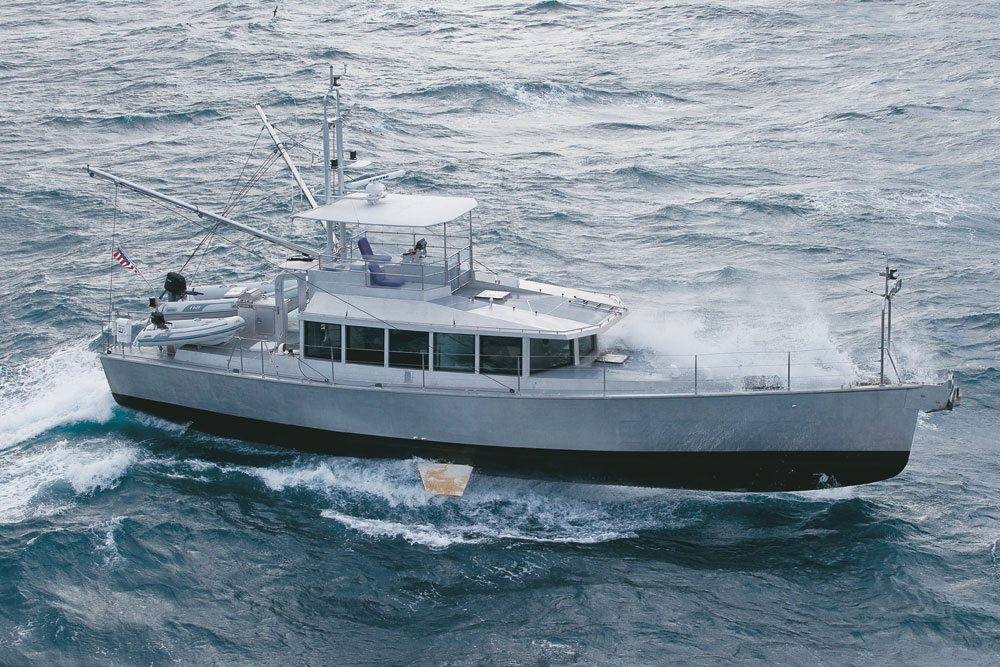In part two of our two-part series on stabilisation, we look at the very latest advancements and changes in the world of fin stabilisers.
For some 40 years, since the first fin stabilisation system was fitted to a yacht, the demands made by owners for improved comfort on a wider variety of vessel types have continued to increase. It is now not only a requirement to supply effective roll-damping devices at cruise conditions, but also the stabiliser system has to work quietly and efficiently at wider speed ranges, as well as at rest.
The determination of the correct size fin stabiliser system for a motor yacht is a fairly straightforward process that involves looking at the speed, displacement and the stability of the vessel.
There are essentially two types of fin stabilisers, fixed or retractable. The fixed-fin stabiliser is suitable for hull shapes where the fin will not protrude beyond the rectangle of the ship’s frame. Fixed- fins are commonly used where space within the hull is limited.
Retractable stabiliser fins can be retracted to inside the hull as to combat some of the disadvantages of a fixed fin. Control of fin movement is automatic and is usually derived from gyroscopic sensing gears.
Active roll stabiliser fins, which are usually mounted on rotatable stocks at the turn of the bilge near the middle of the craft work well and certainly have proven to do the job. Some do it better than others and there are plenty of options and innovations that set one brand apart from another. What is the best system is debatable, but suffice to say if it stops the rock and roll on your boat, then it’s got to be good.
In the last issue, we looked at the latest advances in gyro stabilisation, which offers a whole different solution to stabilisation but with a very similar result. Much has been discussed about which stabiliser is better at reducing boat roll. When looking at some of the differences of fins v gyros, the most obvious is that gyros are inboard and fins are outboard. Because gyro stabilisers require no protrusions from the hull, they ar not subject to damage from grounding, or impact from floating debris. However some of the latest designs have retractable fins, thereby reducing that issue considerably.
Because of their drag at speed, fin systems are generally more suitable for displacement hulls rather than planing hulls. Fin systems are speed dependent, always balancing fin size with projected cruising speed, so as to create minimum drag for desired performance. In the past, at zero speed, it was considered they had no effect (except on very large yachts with long roll periods), and at less than cruising speed, performance dropped off sharply. Not so anymore with a number of reputable brands offering very effective zero-speed stabilisation fin systems.
External zero-speed fins are considerably larger than standard underway fins as they must actively move large volumes of water to stabilise a vessel. These oversized external appendages may result in considerable drag. Some fin designs empirically reduces speed from 1/2 to 1kt depending on the hull type. Any increase in fuel consumption is offset – and in some cases improved – as fin type stabilizers eliminate the wallowing effect of wave action hence run a straighter, truer course.
Fins also have the ability to correct small steady/static heels or listing due to beam winds, off center weight or long period rolls running downwind due to their inherent ability to apply a steady lift force under the hull while the vessel is in motion.

Continually Adjustment
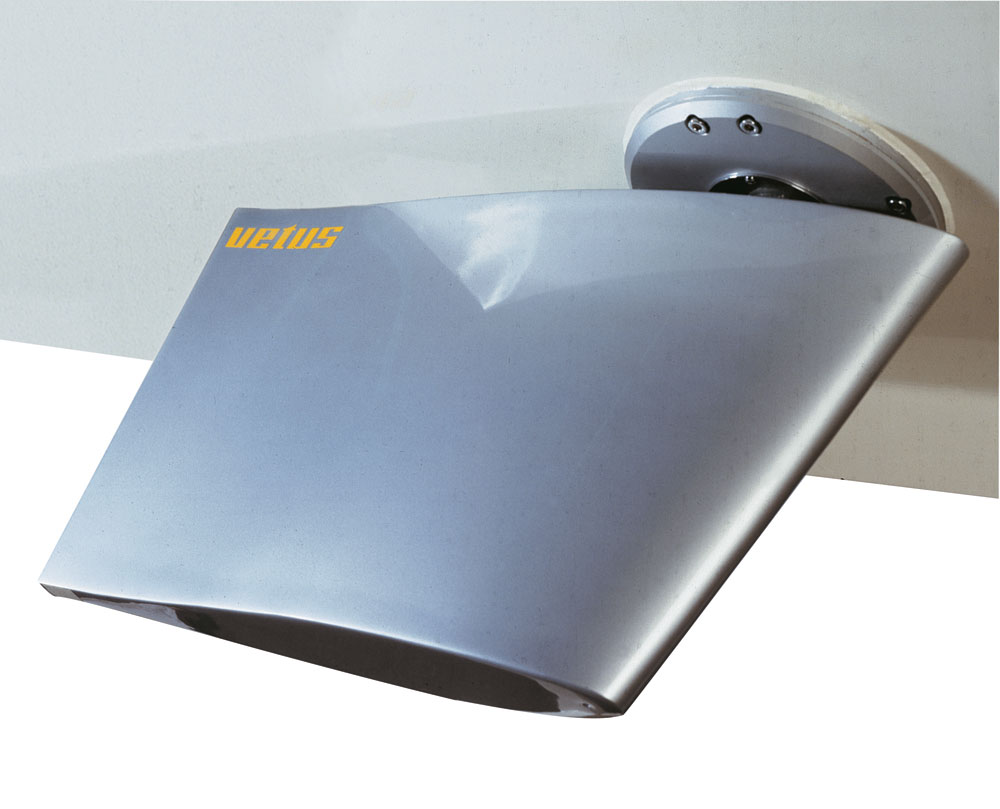
The angle of incidence of the fins is continually adjusted by a control system, which is sensitive to a rolling motion of the craft. Control systems are either analogue or digital.
Depending on their orientation, the fins develop either lift or downforce, which exerts an instantaneous roll moment about the centre of mass of the craft, opposing the instantaneous roll moment applied by the waves, thus reducing or negating the vessel’s roll motion.
Traditional analogue control systems use mechanical systems to measure the rate of roll and then position the fins to compensate. In other words, the vessel has to be already rolling before they will begin to act as roll dampeners.
Digital control systems are now available that use computer processors to establish the heel angle, rate of roll, wind loads or ‘fixed’ heel angles due to trim (dwell angle). These high-speed digital control systems are closing a servo loop to adjust the fin angle up to 200 times per second. Effectively they are sensing roll and acting to counter it before the vessel’s occupants are aware that it is happening, using digital gyro technology.
International trends toward lower speed trawler style or passage making yachts have resulted in very efficient stabiliser installations with hull speeds as low as 6 knots. Fin stabilization systems can also provide stabilisation while at anchor, with roll reduction from 30 % to 50 % being typical, depending on the vessel’s natural roll period.
There has been a lot of development in the field of stabilizer fins and how they work, with companies using electronic integration and major changes in the design shape of fins to maximise their efficiency.
We take a look at some of the recent innovations to fin stabilisers, from some of the world’s leading fin stabiliser manufacturers.
ABT TRAC – Maximum stabilisation

ABT TRAC digital stabiliser fins are available in sizes ranging from 0.4sqm to 4.1 sqm, accommodating boats from 10m to 70m. ABT TRAC’s three-term control detects vessel motion and instantly adjusts fin position to counteract roll. The exclusive fin and winglet are computer optimised to generate the maximum anti-roll force and less drag than conventional fins.
The actuators feature a unique fail-safe capability that mechanically locks the fins when required. No more lifting floorboards or trips to the bilge to “pin the fins.”
They also come with a touch-screen LCD user panel, which is simple and intuitive to operate. With one-touch activation, it automatically adjusts for changes in sea-state, wave angle and vessel speed. The panel features large text and graphic keys. All important information is displayed on the home screen.
The pilothouse panel is a backlit LCD with a touchscreen for command entry. On/Off control is as simple as pressing a button on the screen. There are no special adjustments required for different sea states.
TRAC supply a completely integrated bow and stern thrusters, windlasses, capstans and other deck loads as well as the stabilisers so a TRAC equipped boat comes with an assurance that all those systems will work together seamlessly. Integrating all those systems reduce the overall cost and complexity for the builder and owner.
TRAC stabilisers can be specified as an underway only stabilisation system or more often than not these days, with Zero Speed capability (TRAC Star). For the Zero Speed systems Trac have a different fin under the boat with a longer chord section. The other challenge is providing hydraulic power with the main engines shut down when the boat is at anchor or at rest. This is often achieved with an AC electric powerpack or sometimes with a pump direct driven from a generator.
ABT•TRAC’s line of digital stabilisation systems features seven unique products, each optimised for a specific vessel type. The ABT•-TRAC marine stabilizer automatically adjusts to any sea state for maximum boat stabilization. In late 2014 ABT-TRAC announced Trac Link, an integrated CAN Bus control for Trac stabilizers, thrusters, and auxiliary hydraulic loads. Trac Link control allows multiple touch screen panels and thruster control stations to be connected via simple network cables. Thrusters, stabilizers and auxiliary hydraulics can be controlled from the same touch screen. Trac Link also monitors hydraulic pressure and stabilizer performance.
37Southyachts.com
NAIAD – New Family of Fin Systems

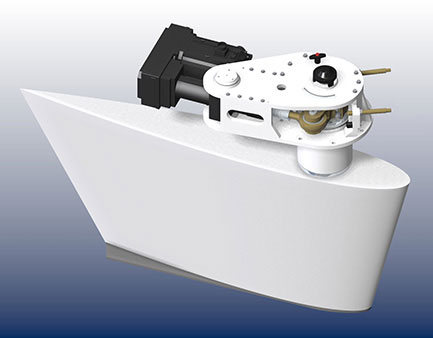
Naiad Dynamics recently introduction a new line of electric-powered stabilizer systems designed specifically for use on ships operating both their AtSpeed and AtRest systems.
“These new stabilizers are a modern refinement of electric-powered stabilizers Naiad first developed for naval applications in 2008,” said John Venables, CEO of Naiad Dynamics. “We are now introducing these systems to the recreational and commercial marine markets alongside our complete range of proven hydraulic stabilizers to provide a choice for designers and builders who may prefer not to use hydraulics.”
The initial model E-525 is available with a 7.5 or 11 kW AC servo motor drive, and is designed for fin sizes ranging from 1.0 to over 3.5 square meters for vessels typically 35 to 50 m in length. The company will roll out additional electric-powered systems through 2015 and 2016.
Naiad’s electric stabilizer eliminates the entire hydraulic system, reducing the number of installed components and the system’s overall complexity and weight, as well as eliminating installation costs associated with interconnecting fluid lines, all with no sacrifice in power and performance. Naiad’s electric servo motor-actuator design generates the same amount of force as two hydraulic cylinders used in an equivalent hydraulic stabilizer model.
Like all Naiad fin stabilizers, these new products are built with the highest-quality materials and workmanship. Major components are machined in-house to U.S. military standards in Naiad’s ISO 9001:2008 certified factory.
The systems’ well-proven heavy-duty tapered roller bearing assemblies are greased for life and sealed at the factory for easy installation, low maintenance and trouble-free operation.
A key safety feature of Naiad’s electric fin stabilizer design is the ability to center the fins manually and lock in place when the stabilizer is not being operated. Other key features include Naiad’s exclusive Datum closed loop digital control system with adaptive self-tuning capability operating on a CANbus distributed network.
Naiad offer 12 different fin sizes to cater for vessels from 9m (Model 162) through to 85m (Model 820).
ROTORSWING - Magnus Effect Stabiliser
Rotorswing is the world’s first electric retractable magnus effect stabilizer. The Magnus effect is described as the force exerted on a rapidly spinning cylinder or sphere moving through air or another fluid in a direction at an angle to the axis of spin. This force is responsible for the swerving of balls when hit or thrown with spin.
RotorSwing is a non-hydraulic roll damping system for yachts up to 30m, which instead of traditional fins, the system uses rapidly rotating cylinders that, subject to the direction of rotation, generate an up or downward pressure.
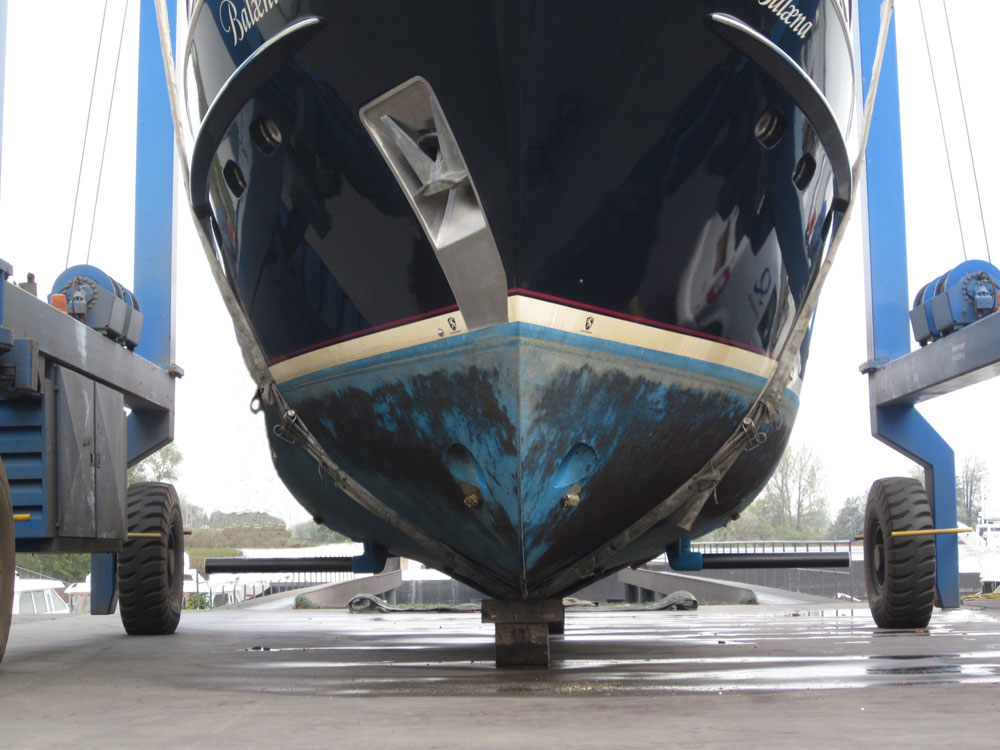
The biggest advantage of RotorSwing in comparison to a fin driven conventional system is the greater roll damping at lower speeds. To achieve effective roll damping with fins, it is necessary to reach a substantial speed through the water. This is partly because often, the surface of the fins have been designed to be as small as possible to reduce the risk of damage. In shallow water, protruding fins are, in particular, very vulnerable.
RotorSwing features retractable rotors, eliminating the risk of damage. The retracted rotors remain largely within the turbulent boundary layer of the vessel so that any resistance is negligible.
If the rotors are in use in the “Drive” position, they can protrude outside the hull of the ship. However, should the engine be put into neutral, the rotors automatically retract. This prevents damage during maneuvering and berthing at quays, in locks and ports.
The rotors do not have any effect on the steering and therefore, unlike fin-based systems, can be mounted at a position of choice. For the majority of vessels, this is likely to be dictated by the onboard available space for the compact electric motor. It is even possible to mount the rotor at the stern.
RotorSwing has no expensive, vulnerable hydraulic pumps, cylinders or high-pressure lines and no risk of oil leaks on board. RotorSwing is a product from RotorSwing Marine, founded by Theo Koop. Theo, the founder and owner of the former KoopNautic Holland, is, for good reason, known as “the Godfather of stabilisers”.
www.sopac.co.nz
KEYPOWER – Innovative fin design
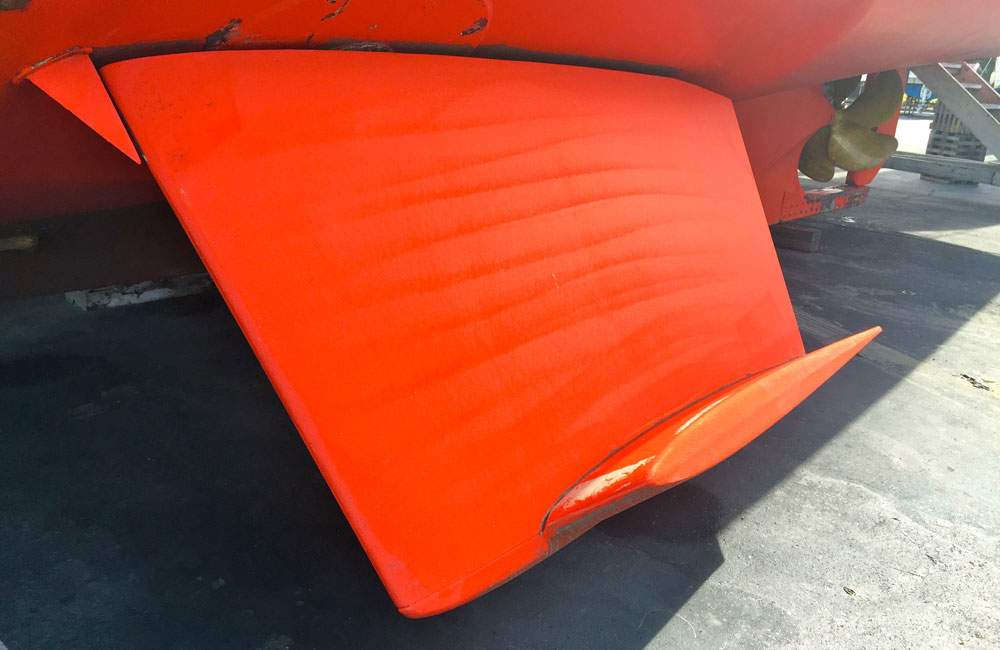
Keypower digital roll fin stabilisers system sets itself apart from other systems
starting with their innovative fin design. Constructed from polyurethane, the fins
have a near neutral buoyancy in the water, require no fin maintenance and its rugged design makes them highly impact resistant.
Keypower offer an array of fin sizes starting from 0.37sqm, going up to 2.23sqm. Each system comes with digital electronic control stations, and can have any custom hydraulic package designed to go with it.
Other features include; auto air bleed, interface to the ships GPS for automatic tuning of sensitivity, multiple control station options and touch screen display panels for easy system monitoring.
They also operate in fully automatic or manual modes and in most cases, runs from the vessels main hydraulic system.
SIDE POWER - Fin Revolution

Sleipner Motor (Side Power) has thought out of the box to produce a fin that better suits many of the modern hull forms to which stabilisers are becoming a standard fit. The elegant, curved shape of the fin beneficially directs force to improve roll reduction and decrease the side effects of yaw and sway. It also increases the leverage arm around the vessel’s rolling axis and minimises drag.
Vector fins simply re-direct the force direction/force vectors to a direction where more of the force will benefit roll reduction and less will be spent on the negative side-effects of yaw and sway that is hurts the boats handling and comfort. The vertical concave shape of the fin, makes the net force directions, both in cruising and in at anchor situations to be re-directed so that they work more “up/down” instead of just parallel to the hull angle.
But there is more, by changing the net force angle, this also increase the leverage arm around the boats rolling point, further enhancing the roll reduction force benefits. This provides a lot more roll stabilization per fin size, which means that drag, power consumption, internal space occupation as well as load on the mechanical parts is a lot less than with other fins that can give a similar roll reduction.
The SPS55 actuators designed specifically for the Side-Power vector fins are incredibly compact and are extremely silent and designed to fit in quite small spaces in modern boats. They have a square base plate that provides a large load distribution area onto the hull while it remains possible to install them in tight areas between stringers and bulkheads. There are also no moving hoses at all, which secures against leakages and potential wear, as well as making the installation easier.
All fins are prepared for any speed function and are available in five sizes from 0.65sqm (VF 650), through to the 1.65sqm (VF 1650). The fins are made in vacuum injected vinylester over pre-shaped core material, with specially designed roving and matt layers.
www.advancetrident.com
WESMAR - First with Electronics
Wesmar, are recognised as the inventor of the electronic gyro powered roll fin stabilisers. The company offer three powerful active stabilisation systems, each with its distinct advantage. The DSP4800 Series uses an advanced new high-powered digital processor and advanced triple axis gyro to add three sophisticated new digital control options, state-of- the-art electronics, and real-time digital wheelhouse display.
Model DSP4801 is the standard digital stabilization model that offers a high-speed gyro and control of roll, with on-screen display of fin movement in real time. The DSP4802 also features a Lift – Gyro, and controller software maintains the fins in a positive lift position during all stabilisation movement.

The Wesmar DSP4803 has all the features of the 4801 and 4802, but with the addition of an At Anchor mode (zero speed). This monitors incoming swells and automatically controls fin movement to reduce the roll.
Wesmar’s DSP4800 active digital stabilizers, instantly react to control the roll by combining a memory component of your vessel’s individual roll factor with input from its digital triple axis gyro to instantly stop the roll.
Wesmar stabilisers are built for heavy-duty service and include load bearing components such as the dual cylinder actuators, which provide added strength and reliability to meet the high performance requirements of vessels, including large, high-speed, high-performance boats. The auto-sensing power supply accepts 12 to 32 VDC and the neutrally buoyant fin design is available in sizes 0.23 to 2.8 Sqm. Rugged, triple layer fin construction features strong and lightweight structural foam.
Wesmar also offers an electronic gyro upgrade package, which allows you to upgrade your existing stabiliser systems with the advanced electronic gyroscope. It does not require replacing existing actuators and fins and works on all models of Wesmar roll fin stabilizers plus those of most other manufacturers.
Unique to the DSP4800 system is a wheelhouse monitor that is controlled by a digital keypad from which the Captain controls the system. Innovative software linked to the stabiliser displays real-time vessel roll and fin movement to correct this roll.
Wesmar’s electronic gyro system delivers lightning speed reaction for exceptional performance. The electronic gyro sensor sends information about roll velocity and acceleration directly to Wesmar’s closed proportional valves, which react instantaneously to rotate the fins. When a desired lift is achieved to counteract the rolling force of a wave, the closed proportional hydraulic system instantly interacts with the electronic gyro to correct the rolling.
www.sopac.co.nz
Summary
Most vessels can be fitted with fin or gyro stabilisation systems either when being built or later as a retrofit. It’s all a question of available space and, of course, cost. Tests have shown unequivocally that fin or gyro stabilization works and works well. There are those who feel that one is better than the other. Some vessels even have both systems installed.
At the end of the day, you need to check all systems out, find what is most suitable for your boat and talk to an expert about what to expect in your particular vessel. Also, take into consideration what’s going to be involved with the installation. Gyros have the advantage of being able to be fitted almost anywhere, whereas fin stabilisers are reasonably restrictive as to where they can go on a hull.
Also, do you want appendages hanging off your hull or would you prefer something inside that effectively does the same job? The luxury with stabilisation systems is that they can be incorporated into any hull form including planing hulls, semi-displacement hulls, displacement hulls, catamarans, wave-piercing hull forms and even more obscure forms.
And if fins or gyros don’t suit you then you can always revert to flopper-stoppers!


